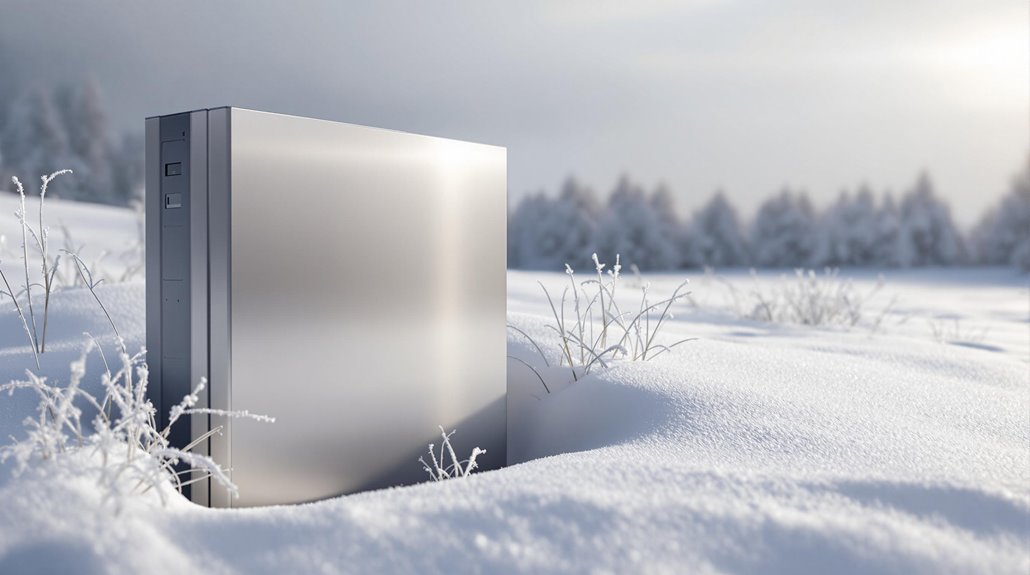Yes, ground source heat pumps (GSHPs) work efficiently in winter. They harness stable underground temperatures, which usually range from 9°C to 11°C, to provide consistent heating. With a Coefficient of Performance (CoP) between 3 and 4, GSHPs offer remarkable efficiency, even outperforming other heating systems such as air source heat pumps in extreme cold. Proper design and maintenance of ground loops are critical, ensuring ideal functionality and preventing issues like ice formation. Additionally, integrating solar energy can further enhance efficiency. As you consider GSHPs for winter use, understanding these details will enhance your appreciation of their capabilities.
Understanding Ground Source Heat Pumps
To grasp how ground source heat pumps (GSHPs) function, it's important to understand their reliance on the stable underground temperatures. Beneath the Earth's surface, temperatures typically range from 9°C to 11°C in the UK when you dig below six meters. This consistent warmth forms the backbone of GSHP operation, allowing them to efficiently extract thermal energy even during the coldest winter months.
By installing horizontal trenches or vertical boreholes, GSHP systems circulate a special fluid through ground loops. This fluid absorbs geothermal heat, which is then transferred indoors, providing a reliable source of warmth. The efficiency of these systems is often quantified by the Coefficient of Performance (CoP). A typical CoP of 4 means that for every unit of electricity consumed, the system generates four units of heat, showcasing impressive efficiency.
Proper sizing and design of the ground loop are essential to maintain ideal performance, as mismatched heating loads can reduce efficiency. Unlike air source heat pumps, GSHPs aren't greatly affected by extreme cold temperatures, ensuring consistent performance. Understanding these fundamentals helps you appreciate the reliability and efficiency of GSHPs for winter heating needs.
Winter Performance of GSHPs
Winter storms might howl, but ground source heat pumps (GSHPs) quietly go about their work, tapping into the Earth's stable underground temperatures. In the UK, these temperatures typically range from 9°C to 11°C, providing a consistent heat source even when air temperatures plummet. You can count on GSHPs to maintain their efficiency during winter by extracting this stable heat, guaranteeing your home stays warm.
To optimize the performance of GSHPs in the colder months, proper thermal modeling and accurate sizing of the ground loop are essential. This guarantees the system meets your property's heating demands without overworking. With a well-installed system, GSHPs can achieve a Coefficient of Performance (CoP) between 3 and 4, offering efficient heating solutions compared to other systems. Unlike air source heat pumps, GSHPs aren't as affected by extreme cold, making them a reliable choice.
Regular maintenance and monitoring are critical to keep your GSHP running smoothly during winter. This can prevent issues like ice formation around the ground loop, which could impede performance. With proper care, GSHPs continue to offer a consistent and efficient heating output throughout the winter season.
Benefits During Cold Months
When the frost bites and the air grows cold, ground source heat pumps (GSHPs) stand out as a powerhouse of efficiency. They draw heat from the ground, which holds a steady temperature between 9°C and 11°C, even when the air outside is frigid. This stable ground temperature means GSHPs deliver consistent heating performance, unlike air source heat pumps that fluctuate with external conditions.
In winter, GSHPs excel because they achieve a higher Coefficient of Performance (CoP), typically ranging from 3 to 5. This means for every unit of electricity consumed, they produce 3 to 5 times the heat energy, showcasing impressive efficiency. Additionally, by using stored solar energy from the ground, GSHPs help cut heating costs, reducing reliance on fossil fuels during peak winter months.
With the right thermal modeling and installation, GSHPs guarantee reliable heating even in harsh winter conditions, maintaining comfort and energy efficiency for homeowners. This capability translates into fewer worries about sudden temperature drops impacting your heating system's performance. By investing in a GSHP, you're choosing a sustainable and economically savvy option for winter heating, providing warmth and peace of mind during the coldest months.
Addressing Common Concerns
Addressing common concerns about ground source heat pumps (GSHPs) helps demystify this efficient technology, especially for those considering its installation. One frequent question is whether GSHPs work well in winter. The answer lies in how they extract heat from the ground, which remains at a stable temperature between 9°C and 11°C below 6 meters deep, irrespective of air temperature fluctuations. This stability guarantees that GSHPs can consistently provide heat, even during extreme cold.
Another concern often raised is about the system's efficiency. GSHPs boast a high Coefficient of Performance (CoP), often exceeding 3, which means they can generate three times more heat energy than the electrical energy they consume. However, the efficiency of a GSHP depends greatly on the design and size of the ground loops. If these loops are inadequately sized, it can lead to reduced performance, especially in colder months.
Additionally, some might worry about the year-round functionality of GSHPs. These systems are versatile, offering both heating in winter and cooling in summer, making them a thorough solution for climate control. Despite lower air temperatures, GSHPs reliably draw heat from the ground, guaranteeing consistent heating.
Enhancing Efficiency in Winter
Maximizing the efficiency of ground source heat pumps (GSHPs) during winter involves a few strategic approaches. First, understand that GSHPs operate efficiently by tapping into stable ground temperatures, which in the UK, range from 9°C to 11°C below 6 meters depth. This consistent heat source allows the system to maintain a high Coefficient of Performance (CoP), often achieving values between 3 and 4. In simpler terms, for every unit of electricity consumed, the system can produce three to four units of heat energy.
To guarantee this efficiency, properly designed ground loops are vital. Accurate thermal modeling helps these loops meet your heating demands without hiccups, even in the chilliest months. Additionally, the low maintenance needs of GSHPs mean they can reliably function throughout winter with minimal intervention, saving you time and effort.
Integrating solar energy can further boost efficiency. Solar panels can supplement the electricity needed for heating, reducing your reliance on external power sources. This integration not only enhances the GSHP's performance but also aligns with sustainable energy practices, offering a more eco-friendly solution for winter heating needs. By implementing these strategies, you can guarantee your GSHP operates at peak performance during winter.


